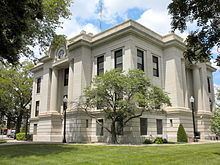Named for William A. Phillips Website phillipscounty.org Area 2,318 km² | Founded 26 February 1867 Population 5,540 (2013) Unemployment rate 3.5% (Apr 2015) | |
 | ||
Rivers Prairie Dog Creek, Bow Creek, North Fork Solomon River | ||
Phillips County (standard abbreviation: PL) is a county located in the U.S. state of Kansas. As of the 2010 census, the county population was 5,642. The largest city and county seat is Phillipsburg.
Contents
- Map of Phillips County KS USA
- Early history
- 19th century
- Geography
- Adjacent counties
- National protected area
- Demographics
- Law and government
- Unified school districts
- Unincorporated communities
- Townships
- References
Map of Phillips County, KS, USA
Early history
For many millennia, the Great Plains of North America was inhabited by nomadic Native Americans. From the 16th century to 18th century, the Kingdom of France claimed ownership of large parts of North America. In 1762, after the French and Indian War, France secretly ceded New France to Spain, per the Treaty of Fontainebleau.
19th century
In 1802, Spain returned most of the land to France, but keeping title to about 7,500 square miles. In 1803, most of the land for modern day Kansas was acquired by the United States from France as part of the 828,000 square mile Louisiana Purchase for 2.83 cents per acre.
In 1854, the Kansas Territory was organized, then in 1861 Kansas became the 34th U.S. state. In 1867, Phillips County was established.
Geography
According to the U.S. Census Bureau, the county has a total area of 895 square miles (2,320 km2), of which 886 square miles (2,290 km2) is land and 8.7 square miles (23 km2) (1.0%) is water.
Adjacent counties
National protected area
Demographics
As of the census of 2000, there were 6,001 people, 2,496 households, and 1,722 families residing in the county. The population density was 7 people per square mile (3/km²). There were 3,088 housing units at an average density of 4 per square mile (1/km²). The racial makeup of the county was 98.25% White, 0.25% Black or African American, 0.30% Native American, 0.45% Asian, 0.03% from other races, and 0.72% from two or more races. 0.67% of the population were Hispanic or Latino of any race.
There were 2,496 households out of which 28.30% had children under the age of 18 living with them, 61.50% were married couples living together, 5.50% had a female householder with no husband present, and 31.00% were non-families. 28.60% of all households were made up of individuals and 15.80% had someone living alone who was 65 years of age or older. The average household size was 2.35 and the average family size was 2.89.
In the county, the population was spread out with 24.50% under the age of 18, 5.70% from 18 to 24, 23.20% from 25 to 44, 24.80% from 45 to 64, and 21.80% who were 65 years of age or older. The median age was 42 years. For every 100 females there were 94.80 males. For every 100 females age 18 and over, there were 91.20 males.
The median income for a household in the county was $35,013, and the median income for a family was $41,638. Males had a median income of $29,609 versus $17,827 for females. The per capita income for the county was $17,121. About 7.20% of families and 10.00% of the population were below the poverty line, including 11.60% of those under age 18 and 8.80% of those age 65 or over.
Law and government
Following amendment to the Kansas Constitution in 1986, the county remained a prohibition, or "dry", county until 1996, when voters approved the sale of alcoholic liquor by the individual drink with a 30% food sales requirement.
Unified school districts
Unincorporated communities
Townships
Phillips County is divided into twenty-five townships. The city of Phillipsburg is considered governmentally independent and is excluded from the census figures for the townships. In the following table, the population center is the largest city (or cities) included in that township's population total, if it is of a significant size.
